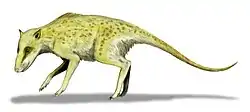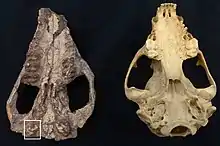Indohyus
Indohyus is a genus of extinct digitigrade artiodactyl known from Eocene fossils in Asia. This small chevrotain-like animal found in the Himalayas is one of the earliest-known relative of whales.[2]
| Indohyus | |
|---|---|
 | |
| Indohyus major | |
| Scientific classification | |
| Kingdom: | Animalia |
| Phylum: | Chordata |
| Class: | Mammalia |
| Order: | Artiodactyla |
| Family: | †Raoellidae |
| Genus: | †Indohyus [1] |
| Species | |
|
I. indirae | |
Description
DNA studies show a close connection between the hippopotamus and whales but there is an age and geographical gap. Hippopotamus are found in Africa and show up in the geological record 15 million years ago, while the earliest whales found in India and Pakistan are 50 million years old.[3][4]

Paleobiology
About the size of a raccoon or domestic cat, this omnivorous pig-like creature shared some of the traits of whales, and showed signs of adaptations to aquatic life. Their bones were similar to the bones of modern creatures such as the hippopotamus, and helped reduce buoyancy so that they could stay underwater.[5] This suggests a survival strategy similar to that of the African mousedeer or water chevrotain which, when threatened by a bird of prey, dives into water and hides beneath the surface for up to four minutes.[6][7]
From isotopes and the structure of the bones in the fossils Indohyus had heavy bones. Heavy bones help reduce the buoyancy of living aquatic mammals so that they do not float up to the surface of the water.[8]
History of discovery
The fossils were discovered among rocks that had been collected in the Kalakot region of Jammu and Kashmir by the Indian geologist A. Ranga Rao who found a few teeth and parts of a jawbone in 1917,[9] but when he died many rocks had yet to be broken open. Ranga Rao's widow gave the rocks to professor Hans Thewissen, who was working on them when his technician accidentally broke one of the skulls they had found and Thewissen recognised the ear structure of the auditory bulla, formed from the ectotympanic bone in a shape which is highly distinctive, found only in the skulls of cetaceans both living and extinct, including Pakicetus.[6]
Classification
Raoellids may be the "missing link" sister group to whales (Cetacea).[10] All other Artiodactyla are "cousins" of these two groups. 18O values and osteosclerotic bones indicate that the raccoon-like or chevrotain-like Indohyus was habitually aquatic, but 13C values suggest that it rarely fed in the water. The authors suggest this documents an intermediate step in the transition back to water completed by the whales, and suggests a new understanding of the evolution of cetaceans.[11][12]
References
- Rao, A Ranga (1971). "New mammals from Murree (Kalakot Zone) of the Himalayan foot hills near Kalakot, Jammu and Kashmir state, India". Journal of the Geological Society of India. 12 (2): 124–34.CS1 maint: ref=harv (link)
- Bajpai, S; Thewissen, JG; Sahni, A (November 2009). "The origin and early evolution of whales: macroevolution documented on the Indian subcontinent". J Biosci. 34 (5): 673–86. doi:10.1007/s12038-009-0060-0. OCLC 565869881. PMID 20009264. S2CID 28232300. Archived from the original on 2017-05-04.CS1 maint: ref=harv (link)
- Borenstein, Seth (December 19, 2007). "Whales may have come deerlike animal". NBC News.
- Briggs, Helen (December 20, 2007). "Whale 'missing link' discovered". BBC News. BBC News.
- Zimmer, Carl (December 19, 2007). "Whales: From So Humble A Beginning..." The Loom, ScienceBlogs. Archived from the original on February 14, 2012.CS1 maint: ref=harv (link)
- Sample, Ian (19 December 2007). "How Bambi evolved into Moby-Dick". Guardian.
- Myers, PZ (19 December 2007). "Indohyus". Pharyngula. ScienceBlogs. Archived from the original on 20 December 2007.CS1 maint: ref=harv (link)
- Zimmer, Carl (2007-12-19). "Whales: From So Humble A Beginning..." National Geographic. National Geographic. Retrieved December 1, 2018.
- Ranga, Rao, A (1971). "New mammals from Murree (Kalakot Zone) of the Himalayan foot hills near Kalakot, Jammu and Kashmir state, India". Journal of the Geological Society of India. 12 (2): 124–134.
- Thewissen, JGM; Cooper, LN; Clementz, MT; Bajpai, S; Tiwari, BN (2007). "Whales originated from aquatic artiodactyls in the Eocene epoch of India" (PDF). Nature. 450 (7173): 1190–4. Bibcode:2007Natur.450.1190T. doi:10.1038/nature06343. PMID 18097400. S2CID 4416444. Archived from the original (PDF) on 2016-03-04.CS1 maint: ref=harv (link)
- Holmes, Bob. "A life spent chasing down how whales evolved". New Scientist. New Scientist. Retrieved December 2, 2018.
- Marx, Felix; Lambert, Oliver; Uhen, Mark (2016). Cetacean Paleobiology (TOPA Topics in Paleobiology) (1st ed.). Wiley-Blackwell. ISBN 978-1118561270.